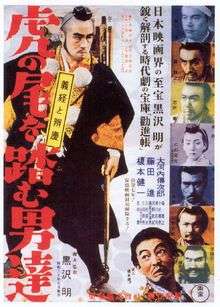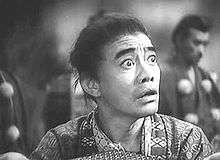The Men Who Tread on the Tiger's Tail
| The Men Who Tread On the Tiger's Tail | |
|---|---|
 | |
| Directed by | Akira Kurosawa |
| Produced by | Motohiko Itō |
| Written by | Akira Kurosawa |
| Starring |
Takashi Shimura Susumu Fujita Denjirō Ōkōchi Iwai Hanshirō X |
| Music by | Tadashi Hattori |
Production company | |
| Distributed by | Toho Company Ltd. |
Release dates |
|
Running time | 59 minutes |
| Country | Japan |
| Language | Japanese |
The Men Who Tread on the Tiger's Tail (虎の尾を踏む男達 Tora no O o Fumu Otokotachi, aka They Who Step on the Tiger's Tail) is a 1945 Japanese period drama film, written and directed by Akira Kurosawa. It is based on the kabuki play Kanjinchō, which is in turn based on the Noh play Ataka.
The film was initially banned by the occupying Supreme Commander of the Allied Powers (SCAP) due to its portrayal of feudal values. It was later released after the signing of the Treaty of San Francisco in 1952.[1]
Plot
In 1185, the Heike family fights against the Minamoto family. After a bloody naval battle in the Pacific Ocean, Yoshitsune Minamoto defeats the enemy and the survivors commit suicide. When the triumphant Yoshitsune arrives in Kyoto, his brother, the Shogun Yoritomo, is uneasy and orders his men to arrest Yoshitsune. However, Yoshitsune escapes with six loyal samurai led by Benkei and they head to the country of his only friend Hidehira Fujiwara. Near the border, after crossing the forest disguised as monks, their porter discovers that they are Yoshitsune and the six samurais and advises that the fearful Kajiwara and his soldiers are waiting for them at the border to arrest them. Yoshitsune disguises as a porter and at the barrier, Benkei has to convince Kajiwara that they are six monks traveling to collect donations to repair the Todai temple in Nara.
Cast


- Denjirō Ōkōchi as Benkei
- Susumu Fujita as Togashi
- Kenichi Enomoto as porter
- Masayuki Mori as Kamei
- Takashi Shimura as Kataoka
- Akitake Kōno as Ise
- Yoshio Kosugi as Suruga
- Iwai Hanshirō X as Yoshitsune (Minamoto no Yoshitsune)
- Demio Yokoo as Hitachibō
- Yasuo Hisamatsu as Kajiwara's messenger
- Shōji Kiyokawa as Togashi's messenger
Sources
External links
| Wikimedia Commons has media related to The Men Who Tread on the Tiger's Tail. |
- The Men Who Tread on the Tiger's Tail at the Internet Movie Database
- The Men Who Tread on the Tiger's Tail at AllMovie
- The Men Who Tread on the Tiger's Tail (Japanese) at the Japanese Movie Database